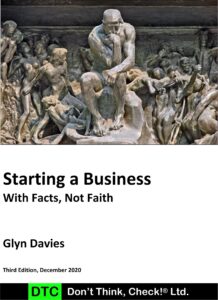
Introduction
Assume that you want to start a burger bar, not unlike, but much better than McDonalds of course. How many burgers do you need to sell to cover all of your costs (both fixed and variable), and then, how many extra do you need to sell in order to make your target profit. The sales volume (number of units sold) where revenue covers all costs and where further sales will result in profit is called the break-even point.
Stated differently, the break-even point is reached when your total sales revenue (total sales revenue = per unit price × number of units sold) completely covers all costs (both fixed and variable) and there is nothing left, not even a profit. Clearly you want to do better than this, but it is useful to know where this point is, that is, how many units do you need to sell? Sell more than the break-even number of units and you make a profit, sell less and you’re going broke.
You can either calculate the break-even point manually, or you can use a Break-even Calculator.
Some terminology
Contribution Margin is the amount per item sold that contributes towards paying for fixed costs (overheads) and provides for some profit.
Contribution Margin = Sale Price per unit – Total Variable Costs per unit
Break-even Discussion
Background Information
Typically, operating restaurants have the following cost structures:
- 30% Food and beverage
- 30% Staff including working owners
- 31-33% Other overheads and profit
- 7-9% Rent
Calculating Break-even Without Profit
For example, set the Sale Price of your burgers to $9, the Total Variable Costs to $6, and then the Contribution Margin per burger is $3 ($9 – $6).
Assume further that your total fixed costs are $70,000 per year, allowing for $44,000 as a salary for you.
How many burgers do you have to sell to reach the break-even point?
Break-even is reached when the following are sold:
- 23,333 burgers per year ($70,000 ÷ $3)
- 467 burgers per week for a 50-week year (23,333 ÷ 50)
- 93 burgers per day per 5-day week, per 50-week year (467 ÷ 5)
Calculating Break-even With Profit
Now extend the example by aiming to earn a reasonable profit of $20,000 per year. This brings our total target revenue or sales figure to $70,000 + $20,000 = $90,000 per year.
How many burgers do you need to sell to reach the break-even with profit:
- 30,000 burgers per year ($90,000 ÷ $3)
- 600 burgers per week for a 50-week year (30,000 ÷ 50)
- 120 burgers per day per 5-day week, per 50-week year (600 ÷ 5)
The disadvantages of break-even analysis include assuming that the selling price is constant at all level of production, that whatever is produced can be sold at the price specified, and that the analysis only applies to a single product. Despite these limitations, the above is a valuable exercise for all businesses. The concern is that the numbers are relatively realistic. In your case, your rent might be higher, or lower, and your variable costs will be different as well. You will also likely sell higher-margin products such as soft drinks, milkshakes, and lollies. You will also have to cater for theft and wastage. But that is all beside the point (no pun intended). For your circumstances, you need to know what your break-even point(s) is(are).
Find your break-even point(s) using the break-even calculator we created within this set of Accounting Templates, or use the one provided by New Zealand Trade and Enterprise.
Summary
To be very blunt, the numbers above reveal what must be achieved every day, every week, and every year. No doubt you’ll have varying sales volumes. But beware that averages risk creating a false sense of security. The concern is that during low periods you may not be able to pay all your bills and as such your debt will likely increase. When debt increases, so will your interest (and principle) payments, making it all the harder to recover should high sales volumes ever return.
Another Example
Assume we’re going to sell greeting cards. Change the selling price to $6, the variable costs to $2, and therefore the contribution margin to $4 while leaving everything else the same. The break-even sales numbers to pay all costs and achieve the profit target are:
- 22,500 sales per year ($90,000 ÷ $4)
- 450 sales per week for a 50-week year (22,500 ÷ 50)
- 90 sales per day per 5-day week, per 50-week year (450 ÷ 5)
Is this in any way remotely realistic? It might be in your context, but you need to be sure.
Below is a graphical representation of what we have discussed from https://www.101computing.net/break-even-point/




